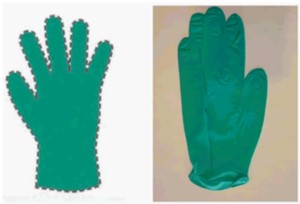
Gloves Off: Court Says No to Green Trademark Protection
The U.S. Court of Appeals for the Federal Circuit held that the test for determining whether a word mark is generic also applies to color marks.
On April 29, 2025, in In re PT Medisafe Technologies, No. 2023-1573 (Fed. Cir. Apr. 29, 2025), the Federal Circuit held that the appropriate test for assessing whether a color mark is generic is a two-step inquiry considering: (i) the genus of goods or services at issue, and (ii) whether the color sought to be registered is understood by the relevant public primarily as a category or type of trade dress for that genus of goods or services.
At issue was a U.S. trademark application to register the color dark green (Pantone 3285 c) for medical examination gloves filed by PT Medisafe Technologies ("Medisafe"), with a drawing and specimen of use as shown below:

The examining attorney refused registration on genericness grounds, and the Trademark Trial and Appeal Board (the "Board") upheld this decision. The Board found screenshots of third-party websites showing unaffiliated sellers using "the same or nearly the same dark green color" to be probative of genericness, while placing little weight on customer declarations and no weight on a flawed survey of three of Medisafe's authorized resellers.
On appeal to the Federal Circuit, the central issue was whether the Board applied the correct legal standard for determining whether a color mark is generic. Medisafe urged that use of the word "term" in the relevant statute meant that there should be a different test to determine whether color was generic. The Federal Circuit rejected that position, explaining that such an interpretation would give color marks more protection, contravening the purpose of the Lanham Act.
Applying the Milwaukee test, the Federal Circuit held that substantial evidence supported the Board's determination that the color green for "chloroprene medical examination gloves" is generic.
This decision provides clarity on the test that applies in assessing whether a color mark is generic and underscores that consumer perception—specifically, whether the relevant public views the proposed mark as a source identifier—is the main driver of the analysis. As such, thoughtful attention to the quality and persuasiveness of evidence submitted in support of an application can make a significant difference in the outcome.





